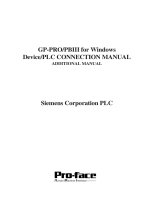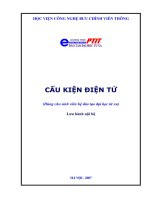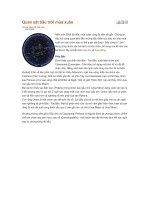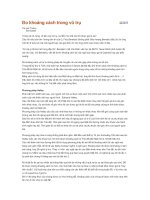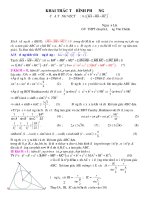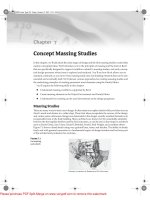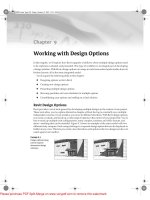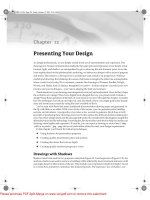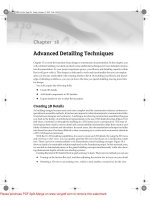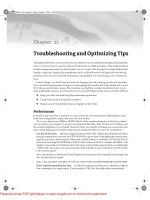Tài liệu Ultrasonic sensors ( http://thisisplc.blogspot.com) ppt
Bạn đang xem bản rút gọn của tài liệu. Xem và tải ngay bản đầy đủ của tài liệu tại đây (34.06 KB, 2 trang )
Carlo Gavazzi’s UA Series ultrasonic sensors
are designed for both distance measurement
and object detection in tough environments.
The range consists of both M18 and M30
housings. Discrete output types are available
for presence and absence detection, and are
ideally suited for detecting objects,such as transparent objects, that cannot be reliably
detected by other sensors.
Analogue output types are available on our sensors for applications requiring a
measurement of the target object, such as detecting the level of fluid in a tank. The
analogue models have your choice of 0-10 VDC or 4-20 mA outputs.
Our more advanced ultrasonic sensor models incorporate teach functions, which allow
the set-points to be configured with the push of a button, and via Windows-based
software for applications where greater control of sensor parameters and variables is
required. The Windows version also allows for settings to be saved and downloaded to
multiple devices.
FAQ Library
Cross Reference
Product Brochure
If you already know the series of sensor, you can click the list below to view the
datasheet.
Q. Please explain the difference between diffuse and through-scan.
Diffuse mode is the standard mode of operation. In this mode, objects travelling in
any direction into the operating range of the sound cone will cause the sensor to
switch output states. The Thru-scan mode uses a "reflector" located in the preset
operating range. This can be any good reflective background, such as a wall. The
operating range is adjusted for the reflector. The pulses are bounced off the
reflector and the echo pulses are returned to the sensor. When a target blocks the
echo pulses, the output is activated.
Q. Where can I get instruction manuals for Carlo Gavazzi ultrasonic sensors?
Instruction manuals for all Carlo Gavazzi ultrasonic sensors are available online.
From the GavazziOnline main page, click on the 'Information' menu button. You
will see a menu item for User Manuals. Click on this and all user manuals for our
products will be shown. Scroll down to the sensors section for the ultrasonic sensors
manuals. GO
Q. Please explain what a blind zone is.
A blind zone exists directly in front of the sensor. It is the range in front of
the sensor where objects cannot be reliably detected, or where an unstable
output would occur. The blind zone will vary depending upon the size and
sensing range of the sensor. Shorter range sensors will have smaller blind
zones, while longer range sensors will have larger blind zones.
Q. Please explain what mutual interference is, and how I can prevent this from
occurring.
Mutual interference occurs when ultrasonic sensors are mounted in close proximity
to each other and the target is in a position to reflect echoes back to a sensor near
the transmitting sensor. To reduce the chance of this occurring, mount adjacent
sensors as far apart as possible, and test the sensors with the target object placed in
the sensing range of one of the sensors. If any of the other sensors detect the echo
from the originating sensor and target object, then re-position the sensors, either
through spacing them further apart, or angling the sensors away from each other.
Q. What effect does temperature and humidity have on ultrasonic sensors?
Temperature: Sound wave speed increases with increase in air temperature.
Humidity: Sound wave speed increases as humidity increases. Increases in
temperature and humidity can cause targets to appear closer when using ultrasonic
sensors.
Q. What effect does the size and shape of the target have on the performance of
ultrasonic sensors?
The ideal target for an ultrasonic sensor is a flat surface, perpendicular to the
sensor. As the flat surface area increases, thereby increasing the total reflective
surface, more of the sound pulse can be reflected, which increases the sensing range.
As the flat surface area decreases, or if the surface area is not flat, less of the sound
pulse can be reflected, which decreases the sensing range.
